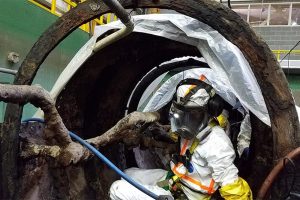(Charleston, SC) – A hardened layer of sand, silt, and shell built up around the Hunley during the 136 years she rested on the ocean floor. This concretion covering the Hunley also masks many of its features and original appearance. Over the past few days, Hunley conservators have been working to remove the concretion on one of the 10 glass ports, which served like skylights, that run along the top of the submarine.
Removing the concretion has allowed scientists to see portions of the Hunley never seen before as well as make a fascinating technological discovery.
The skylight is covered by a hinged iron plate, or deadlight. A pin could be removed from one hinge, allowing the iron plate to drop down and let light into the otherwise dark vessel. To cover the skylight, a crewmember would push the iron plate up, and re-insert the pin.
The deadlights served as both a stealth and safety feature on the Hunley, by stopping light from getting out and water from getting in the submarine.
Candlelight emerging through the Hunley’s skylights would be very visible on the water at night, particularly since the submarine sailed just below the surface. When the deadlight was closed, it would block light from emitting through the skylight, increasing the Hunley’s ability to approach her target unnoticed.
In order to remain as invisible as possible during their mission, the crew most likely closed all the skylights on the night the Hunley sank the USS Housatonic.
The deadlights also served as an important safety feature of the sub’s construction. During combat, if the glass of the skylight was broken, it could cause a dangerous flow of water into the submarine. Scientists think the two hinges holding the iron plate in place may be fitted with rubber gaskets, which would make the skylight watertight when the iron plate was closed. If the glass on the skylight was damaged, the crew could lock the iron plates in place and stop water from overtaking the sub.
Senator Glenn McConnell, Chairman of the Hunley Commission, said, “The Hunley truly is a technological marvel. Every aspect of the submarine’s design is thought out to maximize her ability as a stealth and functional weapon. She is literally 50 years ahead of her time.”
This new revelation about the submarine’s design could also prove to be an important piece of evidence as to why the Hunley vanished. After removing the concretion, Hunley scientists discovered the deadlight was in the shut position and the skylight remained covered.
McConnell said, “Every discovery is a clue that we will ultimately use to solve the mystery of the Hunley’s disappearance. In the crew’s last moments, they chose to leave this skylight closed, perhaps because they believed they would be returning home and wanted to remain undetected. This is another piece of the puzzle that will lead us to the ultimate answer.”
Scientists will continue work on de-concreting the remaining deadlights as they prepare the submarine for its conservation treatment.
Images of the deadlight and x-ray taken of it prior to de-concretion available upon request.
Friends of the Hunley
On the evening of February 17, 1864, the H. L. Hunley became the world’s first successful combat submarine by sinking the USS Housatonic. After signaling to shore that the mission had been accomplished, the submarine and her crew of eight vanished.
Lost at sea for over a century, the Hunley was located in 1995 by Clive Cussler’s National Underwater Agency (NUMA). The hand-cranked vessel was raised in 2000 and delivered to the Warren Lasch Conservation Center, where an international team of scientists are at work conserving the vessel and piecing together clues to solve the mystery of her disappearance.
The material included in this press release is based upon work assisted by a grant from the Department of the Interior, National Park Service.


